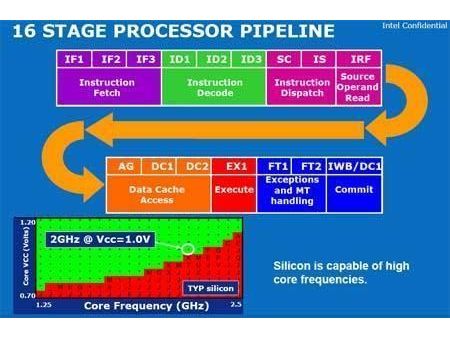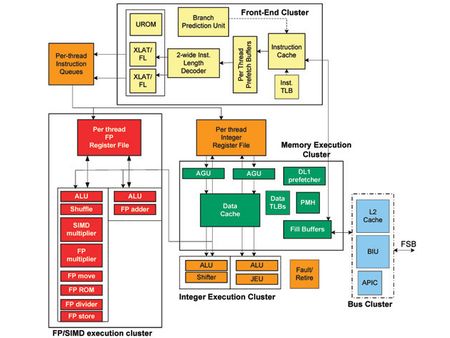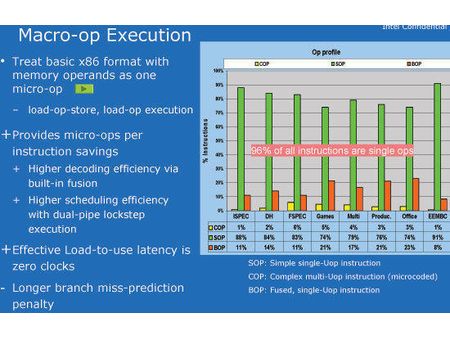Intel Atom CPU Review
Atom: In-Order and HyperThreading
The Atom uses a new architecture, but with older technologies. It’s the first in-order x86 from Intel since the Pentium, back in 1993. All other Intel processors (since the P6) use an out-of-order architecture.
In-Order: Say what?
To simplify, think of the processor as receiving the instructions one by one and putting them in its pipeline before executing them. In an in-order architecture, the instructions are executed in the order in which they arrive, whereas an out-of-order architecture is capable of changing the order in the pipeline. The advantage is that losses can be limited. If, for example, you have a simple calculation instruction, a memory access, then another simple calculation, an in-order architecture will execute the three operations one after the other, whereas in OoO the processor can execute the two calculations at the same time and then the memory access, with an obvious time saving. Quite surprisingly, whereas in-order architectures generally use a short pipeline, the Atom has a 16-stage pipeline, which can be a disadvantage in certain cases.
HyperThreading
HyperThreading is a technology that appeared with the Pentium 4. It can process two threads simultaneously using the unused parts of the pipeline. While not as efficient as two true cores, the technology can make the OS think that the CPU can process two threads simultaneously and increase the computer’s overall performance. On the Atom with its long pipeline coupled to an in-order architecture, HyperThreading is very effective, and the technology can significantly increase performance without impacting the TDP. Intel claims an increase in consumption of only 10%.
The processing core
For the rest, the Atom is equipped with two ALUs (units capable of performing integer calculations) and two FPUs (units dedicated to floating-point calculation and very important for gaming, for example). The first ALU manages shift operations, and the second jumps. All multiplication and addition operations, even in integers, are automatically sent to the FPUs. The first FPU is simple and limited to addition, while the second manages SIMD and multiply/divide operations. Note that the first branch is used in conjunction with the second for 128-bit calculation (the two branches are in 64 bits).
Intel Has Optimized the Basic Instructions
If you look at the number of cycles necessary to execute instructions, you realize something: Some instructions are fast and others are (very) slow. A mov or an add, for example, is executed in one cycle, as on a Core 2 Duo, whereas a multiplication (imul) will take five cycles, compared to only three on the Core architecture. Worse, a floating-point division in 32 bits, for example, takes 31 cycles compared to only 17 (or almost half as many) on a Core 2 Duo. In practice – and Intel willingly admits this – the Atom is optimized to execute the basic instructions quickly, meaning that this processor short-changes performance with complex instructions. This can be checked simply using Everest (for example), which includes a tool for measuring the latencies of instructions.
Get Tom's Hardware's best news and in-depth reviews, straight to your inbox.
Current page: Atom: In-Order and HyperThreading
Prev Page Atom N200 and i945 Next Page Atom: Caches and FSB-
joefriday Celerons have significantly lower frequencies than Atom? umm...no. Only the ULV celeron M has a lower freqency. Modern notebooks start with Celerons at least 1.6GHz, more likely 1.86GHz, and are built on the much more modern Merom architecture, which have at least a 10% IPC advantage over the old Dothan architecture. No, atom is nowhere NEAR a modern Celeron in performance. Nice try though.Reply -
joefriday Also, Why not have a Celeron 420 by now? Are you telling me that THG, with all its money, can't budget in a $30 CPU for comparative testing?Reply -
joefriday After reviewing the article, I can say I'm thoroughly unimpressed with the Atom platform (at least the current desktop derivative). If anyone can remember, THG did a $300 PC build using now ancient Celeron Ds and AMD Semprons. One thing that I find amazing, is that those old rigs both use LESS power than this Atom desktop rig.Reply
http://www.tomshardware.com/reviews/the-300-pc,1546-10.html
-
randomizer Don't you people understand that Atom is not a desktop processor? You can't compare its performance to a desktop processor fairly because that's not what it is designed for.Reply -
joefriday This Atom CPU is on a desktop board. That means it's fair game, especially when the processors being compared are also comparable in price.Reply -
randomizer It's on a desktop board, woopdedoo. If you could get your mobile phone processor to run on a desktop board would you compare it to an E2160?Reply -
joefriday Who cares what the Atom CPU is SUPPOSED to be. It is right now, in this review, on a desktop-oriented package, built to compete with low power consumption desktop computers. It fails miserably in that regard, as it is neither low power consumption, nor competitive. In your ridiculous example, if I had a mobile phone processor on a desktop board, and it ended up consuming more power than an E2160/motherboard combo that costs the same amount of money, all the while performing much worse than the e2160, I would call the mobile phone cpu on a desktop motherboard either A FAILURE or AMD. Take your pick.Reply -
apaige So, for the Intel Atom, you do use an updated version of Sandra, but not for the Phenom. You compare it to the VIA C7, a 3 year-old CPU, but not the VIA Nano, which will be available in the same timeframe as the Atom. You don't provide graphics for power consumption, despite the Atom being designed for low power consumption; surprise, the old C7-M system draws less power.Reply
Biased much? -
Not sure that Nano's are really available yet, still a newer mini-itx based C7 (say EPIA-M700) would have been better, since you would be looking at even less power than the one used and the VX800 will end up used with the Nano. The D201DLY would have been good to compare to, would also give some idea how the Atom would go paired with SiS chipsets.Reply



